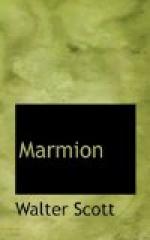“The English line
stretch’d east and west,
And
southward were their faces set;
The Scottish northward
proudly prest,
And
manfully their foes they met.”
The English army advanced in four divisions. On the right, which first engaged, were the sons of Earl Surrey, namely, Thomas Howard, the Admiral of England, and Sir Edmund, the Knight Marshal of the army. Their divisions were separated from each other; but, at the request of Sir Edmund, his brother’s battalion was drawn very near to his own. The centre was commanded by Surrey in person; the left wing by Sir Edward Stanley, with the men of Lancashire, and of the palatinate of Chester. Lord Dacres, with a large body of horse, formed a reserve. When the smoke, which the wind had driven between the armies, was somewhat dispersed, they perceived the Scots, who had moved down the hill in a similar order of battle, and in deep silence. {5} The Earls of Huntley and of Home commanded their left wing, and charged Sir Edmund Howard with such success as entirely to defeat his part of the English right wing. Sir Edmund’s banner was beaten down, and he himself escaped with difficulty to his brother’s division. The Admiral, however, stood firm; and Dacre advancing to his support with the reserve of cavalry, probably between the interval of the divisions commanded by the brothers Howard, appears to have kept the victors in effectual check. Home’s men, chiefly Borderers, began to pillage the baggage of both armies; and their leader is branded, by the Scottish historians, with negligence or treachery. On the other hand, Huntley, on whom they bestow many encomiums, is said, by the English historians, to have left the field after the first charge. Meanwhile the Admiral, whose flank these chiefs ought to have attacked, availed himself of their inactivity, and pushed forward against another large division of the Scottish army in his front, headed by the Earls of Crawford and Montrose, both of whom were slain, and their forces routed. On the left, the success of the English was yet more decisive; for the Scottish right wing, consisting of undisciplined Highlanders, commanded by Lennox and Argyle, was unable to sustain the charge of Sir Edward Stanley, and especially the severe execution of the Lancashire archers. The King and Surrey, who commanded the respective centres of their armies, were meanwhile engaged in close and dubious conflict. James, surrounded by the flower of his kingdom, and impatient of the galling discharge of arrows, supported also by his reserve under Bothwell, charged with such fury that the standard of Surrey was in danger. At that critical moment, Stanley, who had routed the left wing of the Scottish, pursued his career of victory, and arrived on the right flank, and in the rear of James’s division, which, throwing itself into a circle, disputed the battle till night came on. Surrey then drew back his forces; for the Scottish centre not having been broken,




